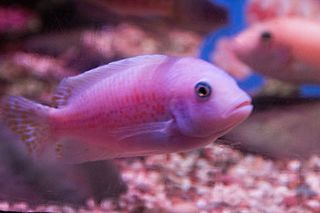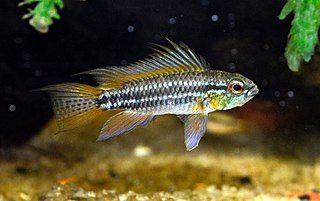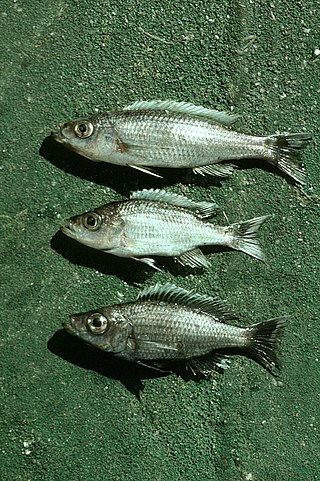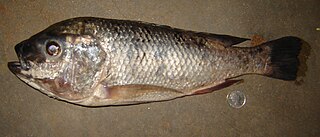
Cichlids are fish from the family Cichlidae in the order Cichliformes. Traditionally Cichlids were classed in a suborder, the Labroidei, along with the wrasses (Labridae), in the order Perciformes, but molecular studies have contradicted this grouping. On the basis of fossil evidence, it first appeared in Tanzania during the Eocene epoch, about 46–45 million years ago. The closest living relative of cichlids is probably the convict blenny, and both families are classified in the 5th edition of Fishes of the World as the two families in the Cichliformes, part of the subseries Ovalentaria. This family is large, diverse, and widely dispersed. At least 1,650 species have been scientifically described, making it one of the largest vertebrate families. New species are discovered annually, and many species remain undescribed. The actual number of species is therefore unknown, with estimates varying between 2,000 and 3,000.

Lake Malawi, also known as Lake Nyasa in Tanzania and Lago Niassa in Mozambique, is an African Great Lake and the southernmost lake in the East African Rift system, located between Malawi, Mozambique and Tanzania.

Mbuna is the common name for a large group of African cichlids from Lake Malawi, and are members of the haplochromine family. The name mbuna means "rockfish" in the language of the Tonga people of Malawi. As the name implies, most mbuna are cichlids that live among the piles of rocks and along the rocky shores of Lake Malawi, as opposed to the utaka, cichlids that live in the open water or on sandy shores or soft substrates. Some species of mbuna are highly sexually dimorphic, although many are not. Almost all of the cichlid species of Lake Malawi, including mbuna and non mbuna such as the utaka, are believed to have descended from one or a very few species that became isolated in the lake. With rising water levels, new habitats could be colonized and the many isolated rocky outcrops allowed new mbuna species to form. Their striking colors, intriguing behavioral characteristics, and relative hardiness make them very popular despite their unique demands for the home aquarist.

Apistogramma is a large genus of freshwater fish in the family Cichlidae native to South America, but also commonly kept in aquariums. They are dwarf cichlids that mostly feed on tiny animals and have breeding behaviors that vary depending on the exact species.

Pseudotropheus is a genus of fishes in the family Cichlidae. These mbuna cichlids are endemic to Lake Malawi in Eastern Africa.

Maylandia or Metriaclima is a genus of haplochromine cichlids endemic to Lake Malawi in East Africa. They belong to the mbuna (rock-dwelling) haplochromines.

Cynotilapia is a genus of haplochromine cichlids. All fishes in these genus form part of the mbuna flock, the rock-dwelling fishes of Lake Malawi, in the rift valley of East Africa. All species are polygamous, maternal, ovophile mouthbrooders and carry their fry in this fashion for about 20–30 days.

Melanochromis is a genus of haplochromine cichlids endemic to Lake Malawi in Eastern Africa. Ecologically, they belong to the rock-dwelling mbuna cichlids of Lake Malawi.

Iodotropheus is a small genus of cichlids endemic to Lake Malawi in east Africa. The genus is distinguished from other genera of mbuna by the upper lip which is usually connected medially to the skin of the snout by a frenum; by its small, terminal mouth; by the outer teeth of both jaws, which are unequally bicuspid and loosely spaced, the tooth shafts inclined slightly toward the jaw symphysis; by the anterior teeth of the upper jaw being much longer and more robust than the lateral and posterior teeth. The rusty cichlid or lavender mbuna, Iodotropheus sprengerae is the most commonly encountered member of the genus in the aquarium trade.

Rhamphochromis is a genus of East African haplochromine cichlids endemic to the Lake Malawi basin, also including Lake Malombe, Lake Chilingali, Chia Lagoon and upper Shire River. They mainly occur in offshore open waters, but a few species also near the coast. They are piscivores that typically feed on lake sardines and small utaka cichlids.

Copadichromis borleyi is a species of haplochromine cichlid fish endemic to Lake Malawi in East Africa. The species is popular in the fishkeeping hobby where it is frequently kept in aquariums. The species has numerous common names, including redfin hap and goldfin hap.
Diplotaxodon argenteus is a species of haplochromine cichlid fish in the family Cichlidae. It is endemic to Lake Malawi. It occurs throughout the lake and therefore is found in Malawi, Mozambique, and Tanzania.
Diplotaxodon ecclesi is a species of haplochromine cichlid. It is endemic to Lake Malawi, in East Africa, where it is found in open water at mainly at the deeper levels, although it is rarely caught by trawling. Its main prey is the Lake Malawi sardine.
Diplotaxodon greenwoodi is a species of haplochromine cichlid which is endemic to Lake Malawi. It occurs in the reef and shelf zones of the lake where it preys on small cichlids. The specific name honours the English ichthyologist Peter Humphry Greenwood (1927-1995).

Diplotaxodon limnothrissa is a species of haplochromine cichlid which is endemic to Lake Malawi and it is found in Malawi, Mozambique, and Tanzania. It occurs in inshore and offshore waters, on reefs and over the rock shelf; and it is abundant over the anoxic zone. It is a maternal mouthbrooder and it feeds on zooplankton. It is probably the most abundant species of cichlid in Lake Malawi. The specific name references the clupeid Limnothrissa miodon, the Lake Tanganyika sardine, to which this species bears some morphological and biological similarities.

Oreochromis karongae is a critically endangered species of cichlid that is endemic to Lake Malawi, Lake Malombe, and upper and middle Shire River in Malawi, Mozambique, and Tanzania. This species is important to local commercial fisheries, but has declined drastically due to overfishing.

Oreochromis lidole is a species of freshwater fish in the family Cichlidae. This tilapia is native to Malawi, Mozambique and Tanzania, where it is found in Lake Malawi, Lake Malombe, the Shire River and perhaps some crater lakes further north. It is important in fisheries, but has drastically declined; it may already be extinct. This oreochromine cichlid is locally called chambo, a name also used for two other closely related species found in the same region, O. karongae and O. squamipinnis.

Oreochromis squamipinnis is a critically endangered species of cichlid fish that is endemic to Lake Malawi, Lake Malombe and Shire River in East Africa, where found in a wide range of habitats, but especially in shallow water. This species is important to local commercial fisheries and can also be found in the aquarium trade, but it has declined drastically due to overfishing.

Labidochromis sp. "Hongi" is an undescribed species of cichlid fish from Eastern Africa. Other names for the fish include kimpuma, Hongi red top and Hongi cichlid. It is well known in the aquarium trade. The maximum size of the species is about 5 inches for the males while the females stay around 3.5 inches.

Hemitaeniochromis brachyrhynchus is a species of fish in the family Cichlidae. Its specific epithet brachyrhynchus refers to the most distinctive characteristic of this species, the reduced length of the head in front of the eye. Prior to the formal description of this species in 2012, the specimen which became the paratype was provisionally called Hemitaeniochromis sp. 'insignis big eye' ; however, the species has no accepted common name.

















